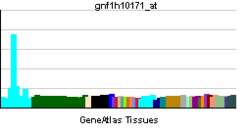- P2RY8
-
Purinergic receptor P2Y, G-protein coupled, 8 Identifiers Symbols P2RY8; MGC50878; P2Y8 External IDs OMIM: 300525 HomoloGene: 65345 IUPHAR: P2RY8 GeneCards: P2RY8 Gene Gene Ontology Molecular function • receptor activity
• G-protein coupled receptor activity
• purinergic nucleotide receptor activity, G-protein coupledCellular component • plasma membrane
• integral to membraneBiological process • signal transduction
• G-protein coupled receptor protein signaling pathwaySources: Amigo / QuickGO RNA expression pattern 

More reference expression data Orthologs Species Human Mouse Entrez 286530 n/a Ensembl ENSG00000182162 n/a UniProt Q86VZ1 n/a RefSeq (mRNA) NM_178129 n/a RefSeq (protein) NP_835230 n/a Location (UCSC) Chr X:
1.58 – 1.66 Mbn/a PubMed search [1] n/a P2Y purinoceptor 8 is a protein that in humans is encoded by the P2RY8 gene.[1][2]
The protein encoded by this gene belongs to the family of G-protein coupled receptors, that are preferentially activated by adenosine and uridine nucleotides. This gene is moderately expressed in undifferentiated HL60 cells, and is located on both chromosomes X and Y.[2]
See also
References
- ^ Adrian K, Bernhard MK, Breitinger HG, Ogilvie A (Sep 2000). "Expression of purinergic receptors (ionotropic P2X1-7 and metabotropic P2Y1-11) during myeloid differentiation of HL60 cells". Biochim Biophys Acta 1492 (1): 127–38. doi:10.1016/S0167-4781(00)00094-4. PMID 11004484.
- ^ a b "Entrez Gene: P2RY8 purinergic receptor P2Y, G-protein coupled, 8". http://www.ncbi.nlm.nih.gov/sites/entrez?Db=gene&Cmd=ShowDetailView&TermToSearch=286530.
Further reading
- Strausberg RL, Feingold EA, Grouse LH, et al. (2003). "Generation and initial analysis of more than 15,000 full-length human and mouse cDNA sequences.". Proc. Natl. Acad. Sci. U.S.A. 99 (26): 16899–903. doi:10.1073/pnas.242603899. PMC 139241. PMID 12477932. http://www.pubmedcentral.nih.gov/articlerender.fcgi?tool=pmcentrez&artid=139241.
- Ota T, Suzuki Y, Nishikawa T, et al. (2004). "Complete sequencing and characterization of 21,243 full-length human cDNAs.". Nat. Genet. 36 (1): 40–5. doi:10.1038/ng1285. PMID 14702039.
- Cantagrel V, Lossi AM, Boulanger S, et al. (2005). "Disruption of a new X linked gene highly expressed in brain in a family with two mentally retarded males.". J. Med. Genet. 41 (10): 736–42. doi:10.1136/jmg.2004.021626. PMC 1735597. PMID 15466006. http://www.pubmedcentral.nih.gov/articlerender.fcgi?tool=pmcentrez&artid=1735597.
- Gerhard DS, Wagner L, Feingold EA, et al. (2004). "The status, quality, and expansion of the NIH full-length cDNA project: the Mammalian Gene Collection (MGC).". Genome Res. 14 (10B): 2121–7. doi:10.1101/gr.2596504. PMC 528928. PMID 15489334. http://www.pubmedcentral.nih.gov/articlerender.fcgi?tool=pmcentrez&artid=528928.
- Ross MT, Grafham DV, Coffey AJ, et al. (2005). "The DNA sequence of the human X chromosome.". Nature 434 (7031): 325–37. doi:10.1038/nature03440. PMC 2665286. PMID 15772651. http://www.pubmedcentral.nih.gov/articlerender.fcgi?tool=pmcentrez&artid=2665286.
- Fujiwara S, Yamashita Y, Choi YL, et al. (2007). "Transforming activity of purinergic receptor P2Y, G protein coupled, 8 revealed by retroviral expression screening.". Leuk. Lymphoma 48 (5): 978–86. doi:10.1080/10428190701225882. PMID 17487742.
- Storlazzi CT, Albano F, Lo Cunsolo C, et al. (2007). "Upregulation of the SOX5 by promoter swapping with the P2RY8 gene in primary splenic follicular lymphoma.". Leukemia 21 (10): 2221–5. doi:10.1038/sj.leu.2404784. PMID 17554380.
Metabolites and
signaling moleculesOtherBile acid · Cannabinoid (CB1, CB2, GPR (18, 55, 119)) · EBI2 · Estrogen · Free fatty acid (1, 2, 3, 4) · Lactate · Lysophosphatidic acid (1, 2, 3, 4, 5, 6) · Lysophospholipid (1, 2, 3, 4, 5, 6, 7, 8) · Niacin (1, 2) · Oxoglutarate · PAF · Sphingosine-1-phosphate (1, 2, 3, 4, 5) · SuccinatePeptideOtherAnaphylatoxin (C3a, C5a) · Angiotensin (1, 2) · Apelin · Bombesin (BRS3, GRPR, NMBR) · Bradykinin (B1, B2) · Chemokine · Cholecystokinin (A, B) · Endothelin (A, B) · Formyl peptide (1, 2, 3) · FSH · Galanin (1, 2, 3) · GHB receptor · Gonadotropin-releasing hormone (1, 2) · Ghrelin · Kisspeptin · Luteinizing hormone/choriogonadotropin · MAS (1, 1L, D, E, F, G, X1, X2, X3, X4) · Melanocortin (1, 2, 3, 4, 5) · MCHR (1, 2) · Motilin · Opioid (Delta, Kappa, Mu, Nociceptin & Zeta, but not Sigma) · Orexin (1, 2) · Oxytocin · Prokineticin (1, 2) · Prolactin-releasing peptide · Relaxin (1, 2, 3, 4) · Somatostatin (1, 2, 3, 4, 5) · Tachykinin (1, 2, 3) · Thyrotropin · Thyrotropin-releasing hormone · Urotensin-II · Vasopressin (1A, 1B, 2)Miscellaneous
Class B: Secretin likeGPR (1, 3, 4, 6, 12, 15, 17, 18, 19, 20, 21, 22, 23, 25, 26, 27, 31, 32, 33, 34, 35, 37, 39, 42, 44, 45, 50, 52, 55, 61, 62, 63, 65, 68, 75, 77, 78, 81, 82, 83, 84, 85, 87, 88, 92, 101, 103, 109A, 109B, 119, 120, 132, 135, 137B, 139, 141, 142, 146, 148, 149, 150, 151, 152, 153, 160, 161, 162, 171, 173, 174, 176, 177, 182, 183)Other
Class C: MetabotropicOtherBrain-specific angiogenesis inhibitor (1, 2, 3) · Cadherin (1, 2, 3) · Calcitonin · CALCRL · CD97 · Corticotropin-releasing hormone (1, 2) · EMR (1, 2, 3) · Glucagon (GR, GIPR, GLP1R, GLP2R) · Growth hormone releasing hormone · PACAPR1 · GPR · Latrophilin (1, 2, 3, ELTD1) · Methuselah-like proteins · Parathyroid hormone (1, 2) · Secretin · Vasoactive intestinal peptide (1, 2)
glutamate / pheromone
Class F:Other
Frizzled / SmoothenedFrizzledSmoothenedCategories:- Human proteins
- Transmembrane receptor stubs
- G protein coupled receptors
Wikimedia Foundation. 2010.
